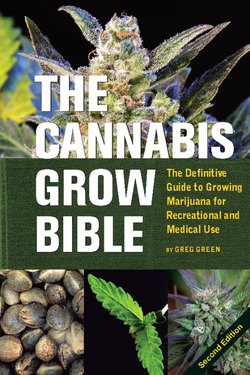Читать книгу The Cannabis Grow Bible - Greg Green - Страница 47
На сайте Литреса книга снята с продажи.
Advanced Sinsemilla Facts
ОглавлениеSinsemilla is a term for a type of “marijuana” first used by the American Spanishspeaking cannabis cultivation community and means “without seeds.” It occurs in cultivation where male plants are removed from the population, leaving only the female plants as part of a plan to promote optimal yields and results. However, with this type of technique there is a chance that fertilization can occur because it produces stress-related sexual change where some dioecious females will express gynodioecious sexuality by bearing male organs. For this reason, great care is taken in choosing a mother plant for a perpetual clone sinsemilla system that will push the female’s genetic capacity for pistil gland production to the maximum. This is undertaken while under the supervision of a grower who will manually remove the presence of any and all male reproductive organs where gynodioecious occurs. Sometimes it is better to remove a whole plant rather than let it pollinate the other sinsemilla-conditioned females. If the gynodioecious sex is too profuse, the grower will usually terminate cultivation of that clone population while trying to find a more suitable mother plant that can be tailor-made for a sinsemilla environment. Here we cannot overemphasize the need for good genetics if the sinsemilla grower wishes to generate the results that he needs.
While there can be some sustainable evidence to support a case for more psychoactive “cannabinoids” in sinsemilla produce, there is little evidence to support that the cannabinoid levels in the glands secreted by the pistils are of higher value. Rather, there is an optimal production of the number of glands.
There is a claim that a female in a sinsemilla environment is being stressed to receive pollen by generating more resin. This image, however, is distorted once more by the presence of high calyx and resin gland counts on some low potency strains and the low calyx low resin count of very high potency strains. The main concern for the cultivator here is to watch males in the flowering cycle of a sinsemilla crop.
These leaves are covered in trichomes and can be used to make hash or for cooking.
Federal research shows that the average potency of cannabis in the United States has increased very little. According to the Federal Potency Monitoring Project, in 1985 the average THC content of commercial-grade marijuana was 2.84 percent, and the average for high-grade sinsemilla in 1985 was 7.17 percent. In 1995, the potency of commercial-grade marijuana averaged 3.73 percent, while the potency of sinsemilla in 1995 averaged 7.51 percent. In 2001, commercial-grade marijuana averaged 4.72 percent THC, and the potency of sinsemilla in 2001 averaged 9.03 percent.40
